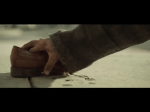A designer Lessons ESL lesson idea developed by George Chilton
I recently gave into the unbearable pressure of society and bought myself an iPad. I wouldn’t say it was cheap, but it has definitely been worth it. I’ve since been able to reduce the number of photocopies and print outs I make by at least half. It’s brilliant for showing videos, displaying photos, recording students, etc., etc. If you’re looking to invest in one, I’d say go for it. I know there are a million and one blog posts about how to use iPads in the classroom, so this won’t be number one million and two.
This is a lesson I planned for an upper intermediate class.
This lesson plan focuses on
- Narrative tenses
- Vocabulary building
- Story telling
- Listening for detail
Featured image by José Luis Ruiz, Flickr
Stage one – Discussion
This is a flexible stage. I feel comfortable with my students (and that they aren’t going to say anything inflammatory), but be wary if you feel that there are unresolved issues between them! Ask your students:
- Is there a difference in the way men and women deal with conflict?
- Do groups of men deal with conflict in the same way as groups of women?
Discuss their ideas – and be non-committal. The objective here is not to unleash latent sexist feelings, nor to reinforce negative stereotypes, but rather to have a brief and adult conversation about the way people tend to communicate. But really, try a different warmer if you feel you’re going to cause conflict yourself!
Have students note down new vocabulary and useful phrases. Use on the spot correction at this stage, but avoid interrupting the flow of conversation where possible.
Stage Two – character description.
The following stills were taken from a high quality short film called One Man’s Loss (6 minutes). I took the screen shots in order on the iPad – this makes it very easy to display if you have a small group – although you could also put the images on a slideshow and project them for a larger group. I would not recommend printing them out, however!
Have Students describe what they see, extrapolating character details where possible.
Help students broaden their descriptive vocabulary by asking for synonyms :
- The man is homeless
- His clothes are uncomfortable
- He looks dishevelled, untidy, scruffy
- His hair and beard are unkempt, messy
- He is shoeless
- He needs a wash.
Do the same for the other stills.
- The business man is vain
- He’s checking himself out / he’s well-off / wealthy / rich
- The girl is lonely / alone
- She is sad / angry / depressed / bored

Stage three – he said / she said.
Put students in pairs and distribute the following sentences (one set per pair). Ask the students to spread the sentences face up on the table. Then tell the students to set aside the following lines of dialogue while they are doing this, as they are part of a different conversation:
Students Set Aside:
Surprise me.
Out of the road idiot! I’ll run your ass over next time
What are you looking at?
Do you drive?
Aaahaaharrr FFFwaaarkkk! Damn
Where to?
Tell the students that the phrases come from an argument. Have students decide if the phrases were said by a man or a woman – by putting the phrases in two columns. Allow up to five minutes for this.
Note that the students might find this difficult – however, the objective here is to have students a) read the sentences in detail, b) find potential new vocabulary, c) discuss their thoughts and differences of opinion. In the end, it does not matter if they are right or wrong. Some of the phrases are quite neutral, and therefore impossible to guess.
I’ve set out the phrases below in no particular order, but in the male and female sets:
Male:
Great another broken window!
You know I can’t understand when you speak French. Why don’t you just calm down?
Those are $500 shoes!
I never said you were stupid…but the way you’ve been acting.
I’m sorry, I didn’t realise you were this upset!
You just gotta trust me okay?
That is so rich coming from you!
She doesn’t mean anything to me.
Female:
Calm down? No I won’t calm down!
You can never admit anything can you?
Such a liar!
Where were you last night? Where?
I don’t drive, idiot.
Don’t touch me!
I’m leaving.
Once Students have finished ordering them, see if there is consensus between the groups. You will likely find that the students have mostly put the sentences in the correct categories.
You can link this back to your previous discussion about how men and women deal with conflict in different ways.
Certain phrases “You just gotta trust me, okay?” and “Don’t touch me!” could obviously be spoken by either a man or a woman, but gender stereotyping and social behaviour lead us to make firm decisions about who is more likely to have said what. Move on if the students don’t find this interesting!
Stage four – Telling the story in images.
This stage will take up the majority of the class time. Your aim here is to develop vocabulary, and improve sentence structures. Do this by mind mapping synonyms, antonyms, and alternative phrasings. Students should be describing emotions and feelings, physical situations, and the progression of the narrative.
Method: Whether using a tablet, or projecting the images, scroll through about five at a time, and have a student tell each section of the story. Pause on important scenes (as illustrated below) every so often to ask students to predict what is coming next, also to speculate on the cause of the argument. Students will see that there are clues (the flowers, the fact the woman is throwing his clothes out of the window, etc.).
Make sure students use the correct grammatical structures for this – using modals of speculation for both the past and future.
- He might have cheated on her.
- I think she’ll leave him.
Obviously, the story telling will differ slightly from student to student, class to class.
I’m not going to tell the story myself here, as that would take a few more thousand words, and wouldn’t really benefit you (!). What you have instead is the video (above) and the image slideshow. Right click on each image to save, or take your own screen shots .
- Who do you think this is? What can you say about his life?
- Describe this man, his position and lifestyle. What kind of a person do you think he is from this first impression?
- Who is the girl? How is she feeling?
- What’s he looking at and why? (himself)
- Describe the homeless man’s appearance.
- What does the title mean? Can you finished the phrase? (…is another man’s gain)
- Where is he going? How is he connected to the other characters?
- What do you think has happened? Why?
- Vocabulary – injured / shard of glass
- What has appeared in this image that wasn’t in the previous one? (a shoe) Why?
- What’s going on in this scene? (broken window)
- What is going on between the two characters? What do you think the argument is about?
- How has this benefited the homeless man? How does this relate to the title of the film?
- what has happened up to this point?
- Predict what is going to happen next.
- What could he be saying?
- What should she do?
- She’s leaving…
- In terms of style, you could say he’s going for Hipster.
- Why is he running?
- Optionally teach “giving the finger, flipping off, or my favourite – flipping the bird.
Stage five – Watching and listening for detail
Students are now going to watch the short film. Tell them to listen carefully because they are going to have to try put the dialogue in the order that it appears. They should do this after they have finished watching the video.
After you have played the video all the way through, discuss how close their idea of the story was.
Put the students in pairs or groups of three and have them put the dialogue (all pieces) in the correct order. Note that the dialogue is not complete, which adds to the complexity of the task.
Once they are happy with their work, replay the video (sound only) and have the students correct themselves.
The order is as follows:
Out of the road idiot! I’ll run your ass over next time
What are you looking at?
Aaahaaharrr FFFwaaarkkk! Damn
Great another broken window!
You know I can’t understand whe you speak French. Why don’t you just calm down?
Calm down? No I won’t calm down!
Those are $500 shoes!
I never said you were stupid…but the way you’ve been acting.
You can never admit anything can you?
Such a liar!
That is so rich coming from you!
Where were you last night? Where?
I’m sorry, I didn’t realise you were this upset!
I don’t drive, idiot.
Don’t touch me!
You just gotta trust me okay?
She doesn’t mean anything to me.
I’m leaving.
Do you drive?
Where to?
Surprise me.
Stage six – Optional follow up
You may well not have time for this, but if you do:
Put students in groups of four and have them decide on the end of the story – what happens next.
The should discuss this for 10 minutes, and present their possible endings in front of the class,
Let me know how it goes!














































great idea!!! Thank you so much! Wish there were more shorter clips such as these